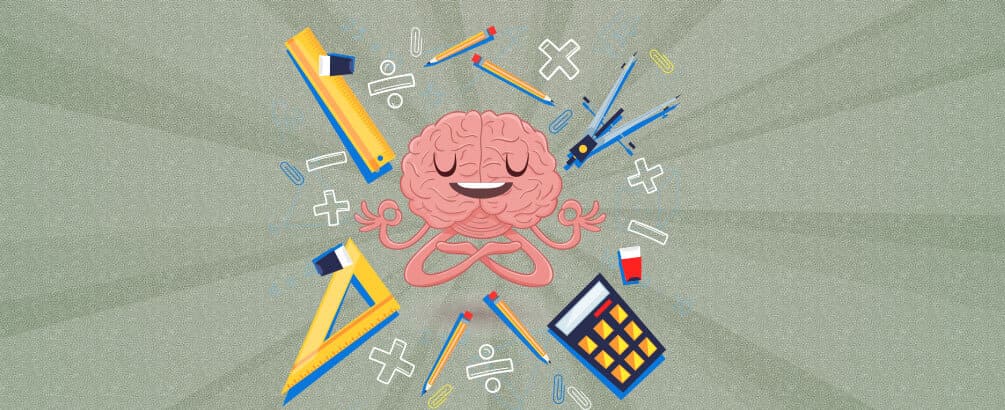Abacus, a tool which consists of beads and rods, can be used to do complex arithmetic operations, such as addition, subtraction, multiplication, division, square root and cubic root. Children do these calculations in the physical rod and with constant practice and training, they can imagine an abacus in mind and perform arithmetic operations on a virtual abacus rapidly and precisely.
Why would one need to master mental abacus techniques?

- Saves time on calculations
- No need to have calculators
- Keeps your brain sharp always
- Improves confidence
So, what is so special about this mental abacus training? It is represented in visual working memory of an Abacus student by splitting the abacus into a series of columns, each of which is independently saved as a unit with its own detailed substructure. It certainly is an impressive and efficient approach, with the concentration, intensity and speed being very impressive.
Even though, Abacus is an ancient way of performing calculations, more research has been conducted in the recent years only especially on the mental abacus abilities helps the kids in enhancing the memory and other cognitive skills.
The studies have revealed that the proper Abacus training may result in qualitative changes in a child’s ability to represent numerical information through the development of a “mental abacus” and improve response inhibition. In addition, the mental abacus skills can be used to develop number concepts, increase efficiency in mathematical calculations, get substantial gains in numerical processing efficiency, and enhance the ability of students to apply mathematical skills to real-life scenarios.
Summary of the studies:

Compared to other subjects, the abacus-trained kids showed higher activity in the right posterior superior parietal lobule/superior occipital gyrus and the right supplementary motor area in both tasks. Moreover, a very important study by Hanakawa et al. [1] provided direct evidence that mental calculations by adult abacus experts experts primarily depended on brain areas involved in visuospatial imagination. The neural correlates associated with three mental-operation tasks (numeral, spatial, and verbal) were compared among experts and controls. The right frontoparietal areas, especially the posterior superior parietal cortex, were significantly activated in the AMC experts compared with the controls during numeral mental-operation tasks. These differences may indicate that more visuospatial/visuomotor imagery processes are involved in mental calculation for AMC experts compared with nonexperts. The neural correlates of mental calculation were also explored in children with AMC training [2]. Simple and complex serial calculation tasks were designed, and the activated patterns found were quite different between the two groups. In the experts, significant activation was mainly observed in the frontotemporal circuit during simple addition and the frontoparietal circuit during complex addition. In the controls, both tasks exhibited similar activation patterns consisting of significant increases in the bilateral inferior parietal lobes and the prefrontal and premotor cortices. These two studies separately indicated that mental calculation processing in adult and child experts primarily depended on the brain areas involved in visuospatial imagination rather than those involved in linguistic information processing.
Several other studies have used fMRI technology to examine the neural correlates underlying abacus mental calculation in adults [3, 4] and children [2,5]. Digit memory and mental calculation in the abacus-trained subjects were associated with the enhanced involvement of neural resources for visuospatial information processing. These neuroimaging findings consistently revealed that abacus-trained subjects are more dependent on the right frontoparietal network for mental calculations.
The researches and studies are still undergoing to understand the neural impact of this skill so that may be translated into educational practice and treatment of people with mathematical disabilities.
References:
- 1.T. Hanakawa, M. Honda, T. Okada, H. Fukuyama, and H. Shibasaki, “Neural correlates underlying mental calculation in abacus experts: a functional magnetic resonance imaging study,” NeuroImage, vol. 19, no. 2, pp. 296–307, 2003.
- 2.F. Chen, Z. Hu, X. Zhao et al., “Neural correlates of serial abacus mental calculation in children: a functional MRI study,” Neuroscience Letters, vol. 403, no. 1-2, pp. 46–51, 2006.
- 3.T. Hanakawa, M. Honda, T. Okada, H. Fukuyama, and H. Shibasaki, “Neural correlates underlying mental calculation in abacus experts: a functional magnetic resonance imaging study,” NeuroImage, vol. 19, no. 2, pp. 296–307, 2003
- 4.C. L. Chen, T. H. Wu, M. C. Cheng et al., “Prospective demonstration of brain plasticity after intensive abacus-based mental calculation training: an fMRI study,” Nuclear Instruments and Methods in Physics Research, Section A: Accelerators, Spectrometers, Detectors and Associated Equipment, vol. 569, no. 2, pp. 567–571, 2006.
- 5.F. Du, F. Chen, Y. Li, Y. Hu, M. Tian, and H. Zhang, “Abacus training modulates the neural correlates of exact and approximate calculations in chinese children: an FMRI study,” BioMed Research International, vol. 2013, Article ID 694075, 12 pages, 2013.
